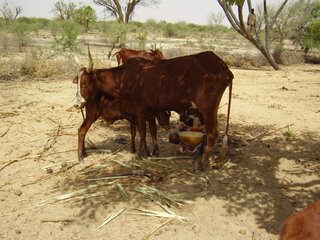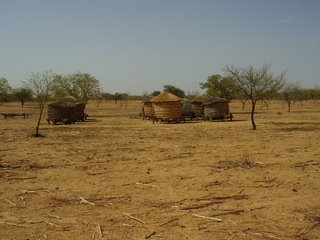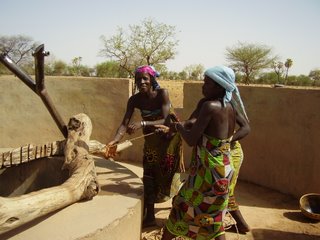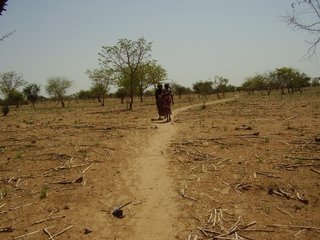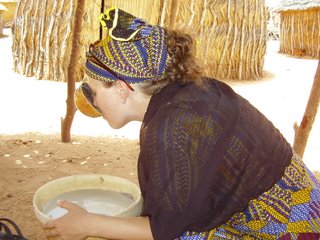#1 – getting settled (22 June 2006)
After cleaning, unpacking, and arranging our new house in Tessaoua, Sarah & I started going out into town. The town is predominantly composed of Hausa people, who thus speak the Hausa language. We have only been able to communicate with them in French, when possible, but are of course picking up quite a bit of Hausa. During the first week we met a very welcoming Fulani family who lives across from us. We are thankful to have located a Fulani family in town and hope to possibly find more. Tessaoua reminds me of a small Southern town, where everyone wonders what the new people are doing in town. Fortunately few people call us out as “anasaras” (white people.) Tessaoua was one of the hardest hit areas during the famine last year; therefore, they are used to seeing foreigners pass through with various aid organizations. Today the only organization that remains is Save the Children. I pray that the people of Tessaoua and the surrounding villages will understand that we are here to help them by sharing Christ’s love with them.
#2 - Getting to the Bush (26 June 2006)
Four days after arriving in Tessaoua, Sarah & I ventured out to the bush for the first time. We visited this particular village several months ago before moving here. We remembered it being about 6 kilometers from town, so we decided to just walk it for the first time. We weren’t quite ready to tackle the bush roads on the motos, especially our first time out. Well boy, was it an adventure. Let me begin with proclaiming that we serve an Awesome & oh-so Faithful God. It was a bit more than 6k out, double that! Yes, Sarah and I walked over 12k to this village – in Niger heat! Only by the grace of God was this possible. Well it was worth it. First of all they were rather impressed with us for walking. Second, they asked, “so you are here to teach us, right?” We told them we indeed were there for that reason, but seeing as how we just walked 12k … I was barely able to say anything. We stayed in the village for a good part of the day, drinking chewtam, chatting, and napping. As we started the walk back to town, Sarah nor I were confident that we could make the whole walk. After walking about 2 k, we stopped for a drink of water and to pray. I prayed for strength, safety, and for any vehicle to come along within the next k. After hydrating, we stood and saw a truck coming down the road! We waved for the truck to stop, but no, it kept trucking along. I don’t know whose mind God changed in that truck, but about ½ k up it stopped and waited for us. The truck was packed with people in the cab, bed, and even on top of the cage that covered the bed of the truck. Communication proved difficult because everyone in the truck only spoke Hausa – no Fulfulde, no French, and well, no English. After saying “Tessaoua” several times, pointing, and of course looking completely exhausted, they understood we wanted a ride. Well I flipped my arms up attempting to ask where we could sit. Oh my! They motioned that the only open space was on top of the truck. I laughed, for I didn’t know what else to do. Sarah and I looked at each other. I looked into the jam-packed bed of the truck. I began climbing on top of truck and told Sarah to climb up or find room in the bed of the truck. She found room, I got a good grip on the cage, planted my feet and off we went. Thankfully, God answered our prayers and we made it safely back into town. Not only that, but we received further invitation to return to the village to begin teaching.
And if you are curious, yes – the next day Sarah and I rested for the majority of the time. Even two days later, I felt like I had been beat.
#3 - On the 2nd day… (28 June 2006)
Upon arranging a day to return to the village to teach, Sarah & I prepared our story. After much prayer and discussion we opted to tell the story of the Good Shepherd. The Fulani are sheep and goat herders, so we thought it would be an appropriate story for that reason and because the point is that He is the only way to the Father.
Before I get to the story part, let me tell you … after walking the 12k Monday, Sarah & I both agreed that we would not make that walk again. So we rode the moto. I drove and Sarah rode on back. It was a long bumpy ride, but much better than walking. We approached the village, and I began to turn further into the bush… we wiped out! And about 10 people saw it. After sitting under a tree and cleaning my wound, one Fulani man pushed the moto further into the bush for me, where we left it and trekked to the leader’s compound.
After greeting the compound and drinking water, the men began walking throughout the bush, calling all the other men. Sarah and I sat there, realizing that they were making this a large gathering…to come hear us teach. That’s when I began getting a bit nervous. After about an hour, all the men they could find were there, sitting with Sarah and I under a millet tent. Sitting in front of 20 Fulani men, I began by asking them questions about their sheep and what shepherds do. Sarah could tell my nerves were going nuts and was very encouraging, praying for me the whole time. About an hour later, the story had been told, questions had been asked, and all said they understood the story. That was a hard and intense hour! God provided the words that came from my mouth, and a Fulani guy who had tremendous patience, helped the others to understand what I had said. In the end, I asked if they wanted to hear more teachings from God’s book. They all said yes.
And yes, on the ride back to town, Sarah & I wiped out again, gaining more bruises and scratches. (I don’t like sand.)
#4 – a long day of traveling (30 June 2006)
Friday morning we left the house in search for a bush taxi to a town 40k from Tessaoua. About three hours later we arrived, after riding in a small bush taxi with more than 20 people. Once we arrived in M*, we hired motorcycle drivers to ride us 10k out through the bush to a Fulani village. Craziness. Thankfully the man driving the motorcycle new what he was doing, and he actually had a motorcycle, not a little moped thingy. It was still scary. I sang, “o Lord my God, when I in awesome wonder, consider all…” most of the ride. The sand is not my friend. For the journey home: We got in a larger bush taxi, with no seats. It was either sit on the floor or stand. I chose to stand and hold on to some bars over head, which made it sort of like a roller coaster ride. There were more than 40 people in the bush taxi sitting, standing, or riding on top. There were more than 20 chickens, 3 sheep (which actually mated part of the trip!), lots of babies, bowls, mats, and other random things. I pulled my shawl over my face and took a good grip. It was a long ride. We stopped in one town on the way back for about an hour while the bush taxi driver visited with friends. Never in America! More than 3 hours later we arrived safely back in Tessaoua, covered in dust! Every ride proves to be a new adventure.
No photos yet, since I am using a public computer. …two more weeks and I’ll have some for you.










